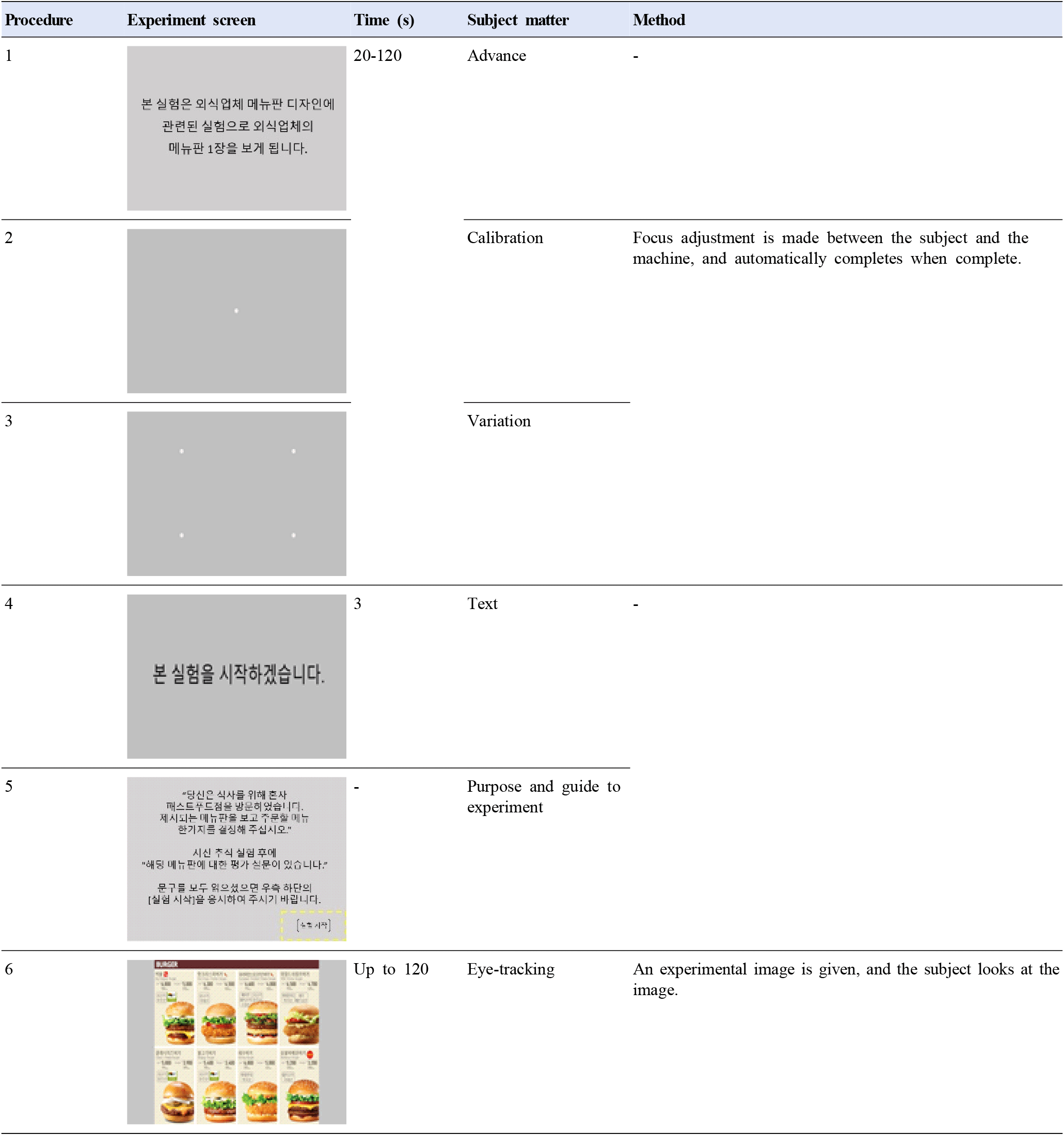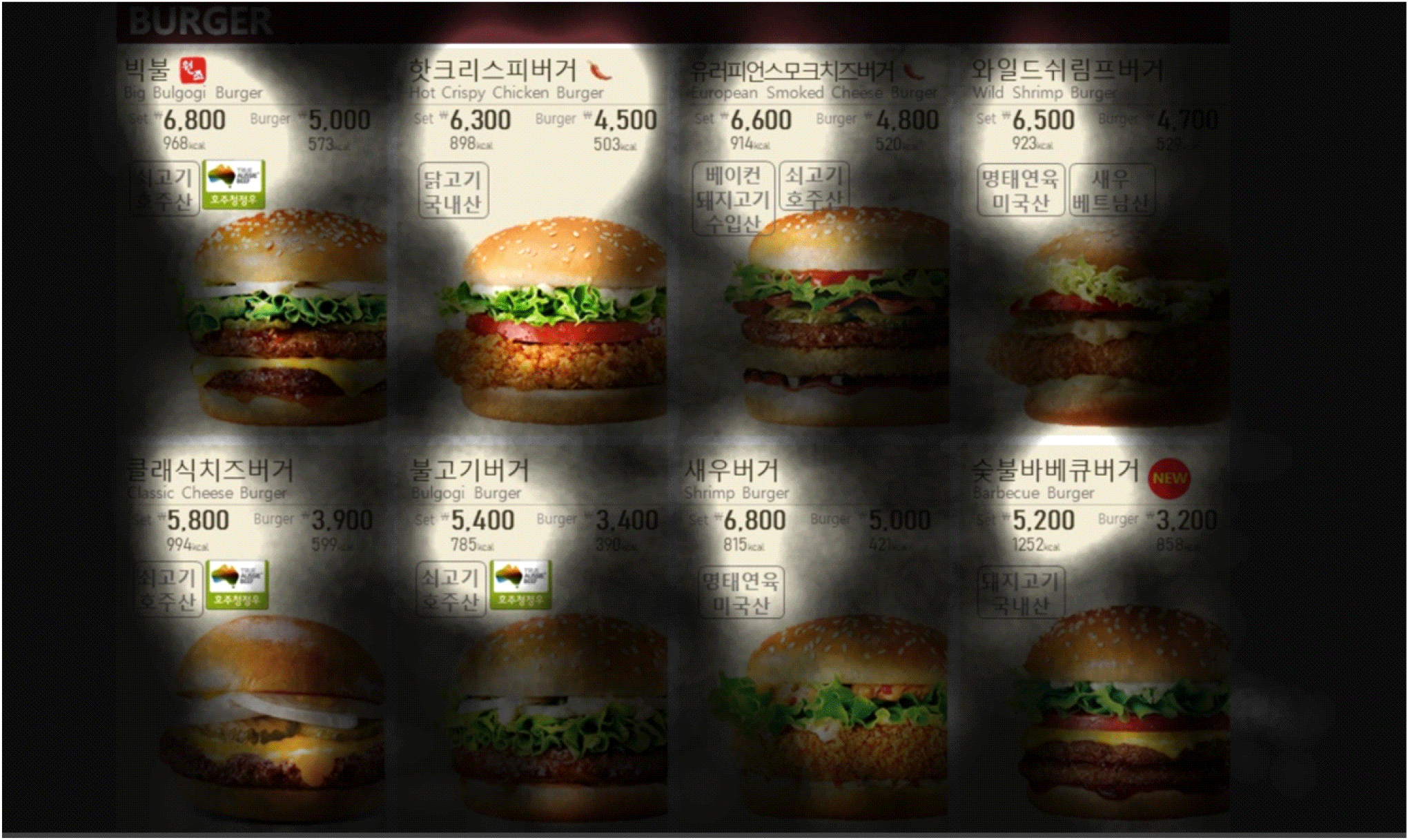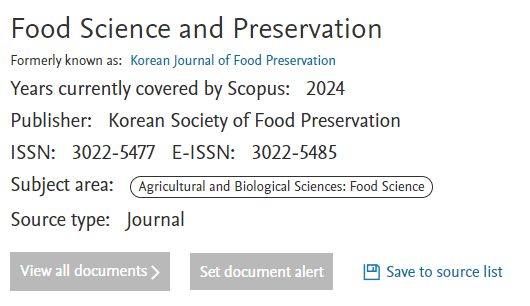1. Introduction
Fast food is a popular choice among university students who prioritize convenience, taste, and cost when selecting food (Driskell et al., 2005; Driskell et al., 2006). In foreign countries, various studies have been applied and studied, such as research on the perception of food information labeling and analysis of gaze behavior on food (Anna et al, 2018; Baoyue and Han, 2015; Gerrit et al, 2018; Kosuke, 2019; Miller and Cassady, 2015). However, fast food is known to have a negative impact on health, as it often contains high amounts of fat and carbohydrates while lacking essential vitamins and minerals found in fruits, vegetables, and dairy products (French et al., 2000; French et al., 2001). Regular consumption of fast food can lead to obesity, increased blood sugar levels, and an increased risk of various diseases, including cardiovascular diseases (Monge et al., 2013; Shah et al., 2014). To address these health concerns, improving nutritional information is seen as a necessary measure to promote national health and prevent obesity. Menu design elements can guide consumers toward nutritional information, but simply displaying this information on menus have been shown to have little effect on promoting healthy food choices (Cowburn and Stockley, 2005). Thus, understanding the factors that attract consumers’ attention to specific menu items is crucial for improving menu design.
Menus are a critical marketing tool for restaurants, as they provide information on menu items such as names, descriptions, and pictures to customers. Since people use more than 80% of their visual perspective to perceive objects or spaces, menu design can be used to attract consumers’ attention to highly profitable items (Kim, 2016; Kwong, 2005). Therefore, analyzing consumers’ gaze while they look at menus is important for studying purchasing behavior. Gaze tracking research can provide objective information on the factors and locations that attract consumers’ attention by tracking and analyzing their gaze (Graham et al., 2012; Kim, 2017; Rebollar et al., 2015).
In gaze-tracking research, eye movements have been found to have a correlation with food selection and quantity (Gere et al., 2016; Manippa et al., 2019). However, the relationship between gaze behavior and food choice may vary depending on the type of food being considered (Wang et al., 2018). Additionally, personal experiences, gender, nationality, cultural differences, lifestyle preferences, emotions, and psychological factors can all contribute to individual differences in gaze behavior, making it challenging to interpret gaze data accurately (Ares et al., 2014; Fenko et al., 2018; Hummel et al., 2018; Motoki et al., 2019; Zhang and Seo, 2015).
While nutritional information on menus has been successful in promoting healthier food choices globally, it remains unclear whether consumers actively seek and use this information. Therefore, this study aimed to investigate the demographic relevance of nutritional information displayed on menus. Specifically, we examined how consumers interacted with nutritional information and the characteristics of visual attention during the menu scanning process. The findings of this study have the potential to inform menu development and nutrition policies by confirming the visibility and influence of nutritional information on menus. According to Kim et al. (2018; 2019), there is a report that the cost of eating out influences menu choices (Kim, 2019). Previously reported by Lee et al. (2011), it was reported that 100,000 won was spent on eating out. Therefore, we proceeded with this research and attempted to analyze recent trends in eye-tracking data. Gender (Park and Kim, 2019) and eating out expenses. Kim et al. (2018; 2019), whether you have experience with menus, calories, ingredients (Kim and Lee, 2014), menu image (Kim and Kim, 2012), major or not (Shin and Chung, 2010) Therefore, we investigated what consumers’ fast food selection criteria are and set menus in the restaurant industry through menu analysis of the main customer groups. We wanted to provide this as important basic research material. Therefore, it was analyzed. formulate a research hypothesis, investigate the trends of the subjects, conduct an experiment to find differences in menu selection, and fixation duration and counts. So, we will study relationship analysis of choosing a menu between many factors on an eye-tracking program.
2. Materials and methods
The menu design was selected based on the consumers’ frequency and total sales among the companies obligated to label the nutrition facts by the Ministry of Food and Drug Safety (MFDS). The selected menu design was produced according to 467.0×330.5 mm and provided to the subject through a monitor.
The AOI (area of interest) was selected by dividing the menu and menu design elements. Each menu was divided into the Big Bulgogi Burger area (BBB), Hot Crispy Chicken Burger area (HCB), European Smoked Cheeseburger area (ESCB), Wild Shrimp Burger area (WSB), Classic Cheeseburger area (CCB), Bulgogi Burger area (BUB), Shrimp Burger area (SB), and Barbecue Burger area (BAB) and was referred to as the 8AOI (Fig. 1A). Each menu design element was divided into menu name, image, country of origin, calorie, price, and special indication, and was referred to as the 6AOI (Fig. 1B).
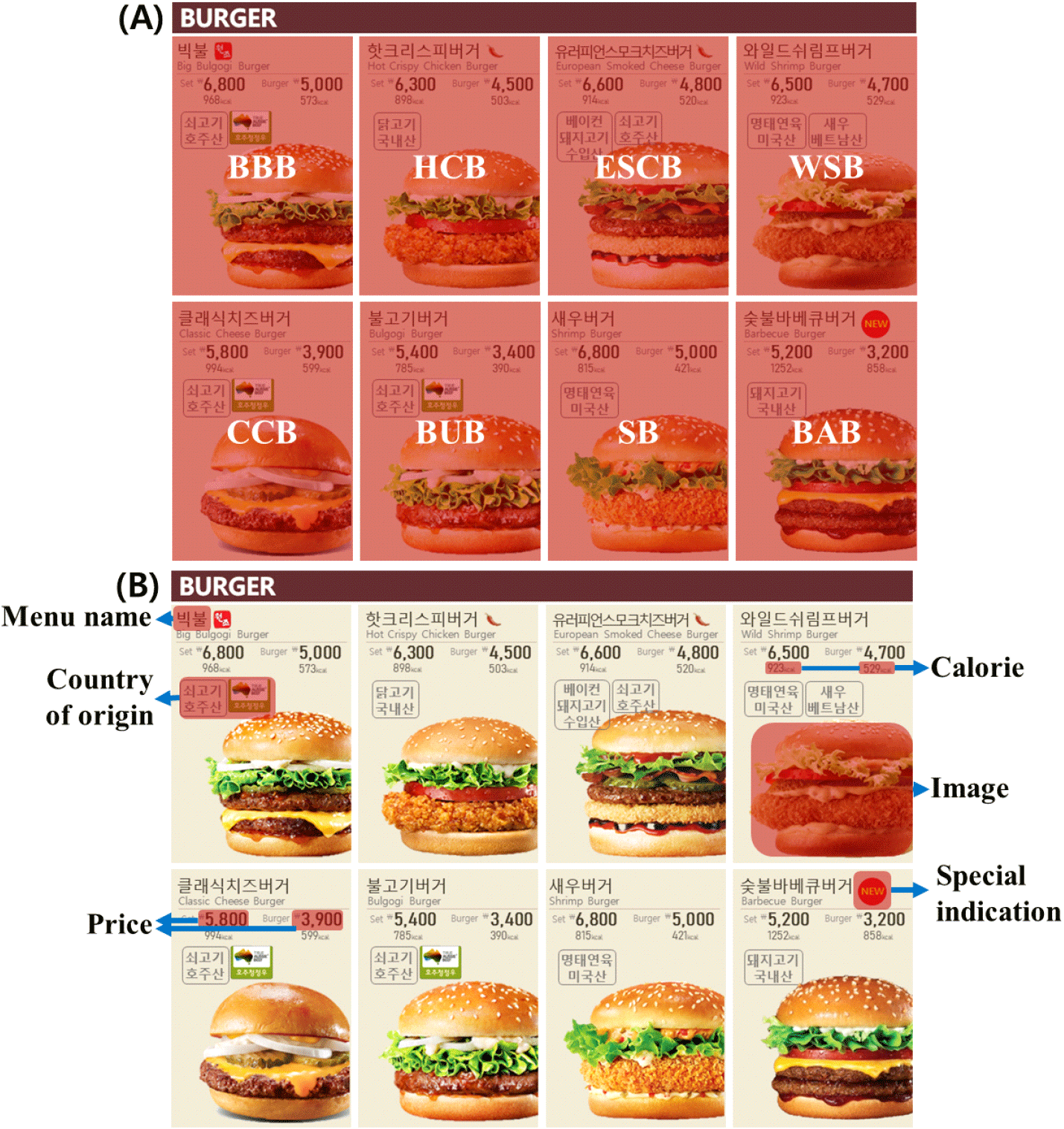
A study was conducted in which 50 male and 50 female students from Jeonju University participated as subjects in an experiment. The study protocol received approval from the research ethics committee at Jeonju University (jjIRB-201109-HR-2020-1102). All participants provided written informed consent, in accordance with the ethical principles for research involving human subjects.
Before the start of the experiment, it was explained as an experiment in which a fast-food menu was viewed and selected without mentioning nutritional information. Specifically, it was described as ‘Please imagine that you have entered a fast-food restaurant and are now looking at the menu. Take your time to review the menu options and select your preferred menu’. Through preliminary experiments, different measurement times, conditions, and data extraction methods were confirmed for each person. The eye tracker (SMI Vision RED-m, SMI Vision Co., Berlin, Germany) was utilized, and the recording frequency of the visual data was 30 Hz. To increase the concentration of the participants, the experiment was conducted in a dark room, and a partition was installed between the subjects and the researcher to prevent intervention in the experiment.
The subjects sat in front of the monitor, while the menu design was not yet visible on the monitor. The experiment was started after confirming the height adjustment of the monitor and maintaining 650 mm. As shown in Fig. 2, the focus adjustment and the produced menu design were provided in a predetermined order. If the eye-tracking experiment time is short, psychological pressure and poor selection may occur (Reutskaja et al., 2011; Van and Trijp, 2011). For this reason, it was conducted for up to 120 s for sufficient gaze movement and data collection. To prevent prior information intervention in this experiment, the survey was conducted immediately after the eye-tracking experiment.
The questionnaire was supplemented appropriately for the study based on preliminary studies on menu selection and nutrition labeling preference. The questionnaire consisted of a total of 9 questions, including 3 questions related to the eye-tracking experiment (menu selection, reason for selection, confirmation of calories), 2 questions related to nutrition (diet experience, education in nutrition), and 4 questions related to demographic characteristics (age, gender, monthly expenditure for dining out), to intuitively grasp the experiment. The questionnaires were structured in the multiple-choice format (excluding age) to facilitate ease of response and data collection.
Data collected through the eye-tracker were extracted using a data extraction device (SMI vision BeGaze 3.0, SMI Vision Co., Berlin, Germany). The extracted data were recorded in units of 0.001 s and were divided into gaze-fixing duration and gaze fixes. The gazed fixation duration used data excluding the saccade value, and the gaze fixations used data by counting the number of times that the movement of the gaze was fixed on one AOI by more than 0.1 s. Valid data was calculated for each experimental subject based on the study by Ko et al (2017). All data, such as excessive eye blinking, long eye rolls, and staring off-screen will be removed, and any data that does not have a validity rate of over 90% of the calculated data will be excluded from the survey.
The analyses of questionnaires and gaze data obtained through the eye-tracker were analyzed using one-way ANOVA and Duncan’s multiple range test using the SPSS program (IBM SPSS Statistics 24, SPSS Inc., New York, USA). Principal component analysis (PCA) was performed using XLSTAT (version 2021.4.1, Addin Soft, New York, USA) to confirm the correlation of the gaze fixation duration and gaze fixations for the questionnaire item.
3. Results and discussion
Table 1 presents the experimental details and demographic characteristics of the participants. The most selected menus were HCB, followed by ESCB and BBB. Regarding the reasons for menu selection, 39% chose the menu they always ate, while 26% considered the ingredients, 23% relied on the menu image, 6% tried new menus, and 5% chose menus based on price. Only 1% of the participants selected menus based on calorie information. During the experiment, 54% of the participants confirmed that they had seen the calorie information on the menu, while more than 46% of the respondents reported that they had not noticed the calorie information. Demographically, most of the participants were women, and the average age was 21.23 years monthly expenditures for dining out, 33% spent between 300,000 and 390,000 won, while 6% spent less than 200,000 won. Among the total participant data, the 63 subjects who passed the validity test showed no significant differences compared to the overall data, except for menu selection and monthly expenditure for dining out. The data analysis was conducted in Jeonju.
Table 2 analyzes the frequency of menu selection and various factors in the eye-tracking experiment data experiment. Regarding the menu frequency selected in Table 2, HCB (Hot Crispy Burger) was significantly more frequently selected at 39.7% (22 people). ESCB (European Smoked Cheeseburger) 14.3% (9 people), WSB (Wild Shrimp Burger) 11.1% (7 people), SB (Shrimp Burger) 9.5% (6 people), SB (Charcoal BBQ Burger) 9.5% (6 people), BBB (Big Bull) at 6.3% (4 people), CB (Classic Cheeseburger) and BB (Bulgogi Burger) at 4.8% (3 people) each. In the experimental group, there were many male subjects (22 subjects) and female subjects (41 subjects). The men’s menu choices were Hot Crispy Burger 31.8% (7 people), European Smoked Cheeseburger 22.7% (5 people), Charcoal BBQ Burger 13.6% (3 people), Classic Cheeseburger 9.1% (2 people), Yakiniku Burger 9.1% (2 people), Big Bull 4.5% (1 person), Wild Shrimp Burger 4.5% (1 person), Shrimp Burger 4.5% (1 person), and Hot Crispy Burger 43.9% (18 people) were women. Wild Shrimp Burger 14.6% (6 people), Shrimp Burger 12.2% (5 people), European Smoked Cheeseburger 9.8% (4 people), Big Bull 7.3% (3 people), Charcoal Barbecue Burger 7.3% (3 people), Classic Cheeseburger 2.4% (1 person), Yakiniku Burger 2.4% (1 person), in that order, and the differences between the male and female groups were noticeable. Although the Hot Crispy Burger was chosen most frequently for all menu items, the ranking of the menu choices listed below showed a difference in the proportions between the two male and female groups. For men, the percentage of choices for European Smoked Cheeseburger, Classic Cheeseburger, Yakiniku Burger, and Charcoal Barbecue Burger was higher than for women, and for women, the percentage of choice for Big Bull, Wild Shrimp Burger, and Shrimp Burger was higher than for men. Overall, women preferred menus with shrimp patties more than men, and men had a higher preference for menus with meat or cheese patties (p<0.001). In the questionnaire regarding whether or not they have ever experienced dieting, 71.4% (45 people) of the group who had tried dieting were more likely than those who had not experienced dieting 28.6% (18 people). This was found to be slightly higher than the 65.1% of Kim (2015), who investigated the actual situation of students enrolled at Gyeonggi Station and Gangwon Regional University by type. According to a report by Kim (2017), who analyzed the degree of weight loss desired by BMI index for male and female university students, the higher the BMI (<27.5 kg/m2), the higher the weight loss rate is 11 kg or more and the weight desired to be reduced increases. They had reported that. Therefore, in this study, the presence or absence of the dieting experience was similar to the report that female students experienced dieting more influenced by obesity rates (National Health Insurance Service, 2020). As a result, in the group that had experienced the diet, 37.8% (17 people) of Hot Crispy Burger, 17.8% (8 people) of European Smoked Cheeseburger, 11.1% (5 people) of Wild Shrimp Burger, 11.1% (5 people) of Shrimp Burger, S Charcoal BBQ Burger 11.1% (5 people), Classic Cheeseburger 6.7% (3 people), Big Bull 4.4% (2 people) were the most chosen, in that order, and Yakiniku Burger was not chosen. In the group that had not experienced dieting, 44.4% (8 people) of Hot Crispy Burger, 16.7% (3 people) of Yakiniku Burger, 11.1% (2 people) of Big Bull, 11.1% (2 people) of Wild Shrimp Burger, and 11.1% (2 people) of European Smoked Cheese. It was found that 5.6% (1 person) chose the burger, 5.6% (1 person) the Shrimp Burger, and 5.6% (1 person) the Charcoal-Grilled Barbecue Burger, but not the Classic Cheeseburger. The menu with the lowest calories was not selected by the Yakiniku Burger group, even among those who had tried dieting, suggesting that calories were not a major factor when choosing a menu at a fast food restaurant. When asked why they chose the menu, 25.4% (16 people) said “Because it has the ingredients I like,” 36.5% (23 people) said “Because it’s the menu I always eat,” and 36.5% (23 people) said “Because it has the ingredients I like.”, “It looks delicious,” he replied. 25.4% (16 people) of the people selected the most menus, which is thought to be partly due to the fact that consumers have a lot of experience, and they select menus by grasping menu information based on external factors such as favorite ingredients and images. It seems that it will. In the case of the Hot Crispy Burger, which was chosen from the most from the menu, respondents also answered, “Because I always eat it (12 people),” which accounted for the most experience points. Previous studies have shown that there are differences in a variety of factors, including the level of spending on eating out, price sensitivity, menu-oriented style, and factors considered important among menu attributes (Kim, 2018; Kim, 2019; Lee, 2018). In this experiment, comparisons were made according to the monthly average expenditure on eating out. This was higher than the study by Lee (2011), reported that the average monthly expenditure on eating out was most often in the 200,000 to 290,000 won range, and the most common was less than 100,000 won. In 2018, the results of a study conducted on university students in the Uijeongbu area were found to be similar to those of Kim (2018) regarding expenditure on eating out. This is likely due to factors such as the rise in prices from 10 years ago. Among the selection criteria for fast food, Hot Crispy Burger (30%) was the highest, and the frequency of choosing Charcoal Barbecue Burger, which was the cheapest option, was not high even among the groups who spent less than 200,000 won on eating out, and there was a significant difference. A Yakiniku Burger appeared and one person also selected the menu. As a result, the menu was not selected according to the level of expenditure on eating out, but the experience of eating was the most important factor in determining the menu. Additional research is needed, such as menu design components other than price.
2) %, The ratio of the number of participants selected to the total number of participants.
2) BBB, select big Bulgogi Burger; HCB, select Hot Crispy Chicken Burger; ESCB, select European Smoked Cheeseburger; WSB, select Wild Shrimp Burger; CCB, select Classic Cheeseburger; BUB, select Bulgogi Burger; SB, select Shrimp Burger; BAB, select Barbecue Burger.
The heatmap is a screen used for analyzing eye gaze data that displays the area where the gaze fixates on after presenting stimuli to the subjects with a highlight effect. Our study found that HCB, which had the most menu choices, received more gaze fixations compared to other menus, with the main focus being on the menu name and price (Fig. 3). Additionally, the space between the menus was slightly brighter than the surrounding area, and the gaze traveled mainly at the top of the menu rather than the bottom. As the gaze was focused on various informational elements of the product where much relevant information was gathered (Hwang and Kim, 2013), this study confirmed that the gaze movement at the top of the menu makes it easier to compare information between menus. When we examined the gaze movements according to menu selection (Fig. 4), we found that the subjects stared at the menu of their choice with wider gazes and focused on the image. The heatmap also compared the selected menu with the menu close to it and the subjects’ gazes, which could potentially affect food choices because even if the gaze is fixed in one place, the surrounding information can still be recognized (Yokoyama et al., 2014).
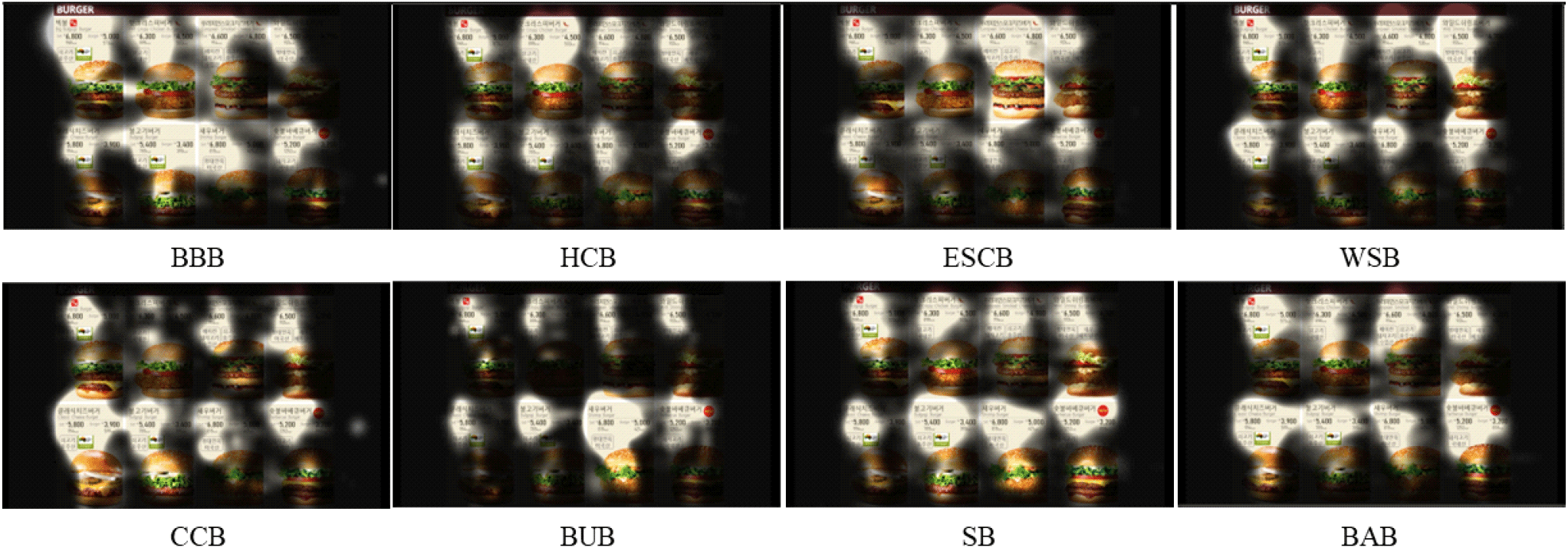
Fig. 5 illustrates the results of an examination of changes in gaze fixation duration for six areas of interest (AOI) over time, by dividing the experimental time into 10-second intervals. Initially, it was observed that participants focused on the menu name, followed by the image and price. During the 20-40 second periods, the gaze fixation durations for price and image were similar, but then they became inversely related. This may be due to differences in the amount of information that can be acquired from the image compared to the price.

According to Reale and Flint (2016), a menu with simple information can be selected in a short time, typically within 5 to 7 seconds. However, the menu used in this study contained various types of information, and thus required more time to process. The areas indicating calorie and special indications showed little change during the experiment, as they are small and remain within the field of vision even when focusing on the menu name. Therefore, additional gaze fixation duration for these areas may not be necessary.
The study found that regardless of the selected menu, the menu name and image were viewed the longest, followed by country of origin, price, calories, and special indications (p<0.05). In addition, 50.8% of the reasons for choosing a menu were related to ‘food’ and ‘image’, which was significantly higher than other reasons for selection, except Universal Choice (always eaten menu) (Table 1). There was no significant difference in the time to stare at the menu name in BBB, HCB, WSB, BUB and BAB, but only ESCB was briefly stared to show significance (p<0.05). In terms of menu price, BUB stared for 35.5 seconds and showed significance. There was no significant difference between menus in terms of calories. In the country of origin, it was shown that it was observed for the longest time by staring for 19.1 seconds at CCB, and there was no significant difference in the rest of the menu. Images were observed for the longest time in the ESCB menu (48.7 seconds) and also in SB for a relatively long time at 32.5 seconds, with no significant difference. ESCB menu is one of the most popular menus. The rest of the menus were observed relatively briefly (Table 3 row). Special indications were not signed. People looked at the menu name for the longest time (35.5 seconds), price (21.6 seconds), image (16.0 seconds), Country of origin (8.81 seconds), Calorie (4.6 seconds), Color (0 second). Menu name is the most important factor to take.
BBB, select Big Bulgogi Burger; HCB, select Hot Crispy Chicken Burger; ESCB, select European Smoked Cheeseburger; WSB, select Wild Shrimp Burger; CCB, select Classic Cheeseburger; BUB, select Bulgogi Burger; SB, select Shrimp Burger; BAB, select Barbecue Burger.
5 Areas information on ingredients can be checked through the menu name and image, and it was judged to be the most effective menu design element that provides information to consumers. The menu name frequently held the subjects’ stares, and the average fixation time for it was longer. This suggests that the menu name and image are actively used when comparing menus, but the image helps to understand product information faster than the menu name. Human behavior is influenced by the interaction of rational and intuitive information (Epstein, 1994). According to the results, it is judged that the menu name and image intuitively convey information to consumers.
Table 3 presents the results of gaze fixation duration of 6 AOI within the menu selected by the subjects. In Table 3, menu name, the average time of menu selection and gaze fixation according to 6AOI was BUB (35.5 seconds), CCB (34.8 seconds), WSB (34.2 seconds), BAB (25.5 seconds), HCB (24.8 seconds), and BBB (24.2 seconds) were all significantly long-term menus (p<0.05). Among the menus in Table 3, it was found that ESCB (17.9 seconds) was the shortest. The price was the most significant as I looked at the Bulgogi Burger (BUB) for the longest time (21.6 seconds, p<0.05), and there was no significant difference in the rest of the menu. When choosing a Bulgogi Burger (BUB) menu, it was found that they were selected in the order of name (35.5 seconds), price (21.6 seconds), image (16 seconds), country of origin (8.8 seconds), calories (4.6 seconds), and special indication (0.6 seconds) (p<0.05). In particular, ESCB hamburgers were found to stare at the image for the longest time (p<0.05). In other studies, the importance of nutritional information is lowered because products have many elements (name, price and images, etc.) that have various information (Ma and Zhuang, 2021).
On the other hand, calories showed lower gaze fixation duration and gaze fixes compared to other factors. Consumers generally rely on the easy and intuitive part, and the larger the stimulus, the longer they stare (Drèze and Husherr, 2003; Milosavljevic and Cerf, 2008). This is a result that is in good agreement with this study. For this reason, even in restaurants, nutrients are displayed smaller than menu names and images, and the proportion of active users is low (Jun et al., 2009). Therefore, it seems that calories were not used in menu selection because they were less stimulating than other elements and were not intuitive.
WSB (44.7 times) took the most average number of gaze tests on the menu, with BBC (36.7 times), CCB (35 times), and BAB (27.2 times), compared to HCB (29.6 times), SB (26.8 times), and ESCB (22.1 times). There was a significant difference (p<0.05), and there was no significant difference between BBB and each other. BBB and CCB took the average number of gaze tests for the price the most with 14.3 times, and there was a significant difference from ESCB (7.1 times), HCB (12.3 times), and WSB (10.1 times) (p<0.05). The mean counts of applications for the calorie were significant only in BBB (13.8 times) (p<0.05). The average number of gazes for images accounts for high in the order of SB, ESCB, BBB, HCB and WSB, and there was no significant difference between CCB and BUB (Table 4). In terms of the number of gaze tests, WSBC took the most, BBB and CCB were advantageous in terms of price, and SB took the most images. The menu of gaze time and the account of the appeared differently.
BBB, select big Bulgogi Burger; HCB, select Hot Crispy Chicken Burger; ESCB, select European Smoked Cheeseburger; WSB, select Wild Shrimp Burger; CCB, select Classic Cheeseburger; BUB, select Bulgogi Burger; SB, select Shrimp Burger; BAB, select Barbecue Burger.
A vector other than zero that is a constant multiple of itself is called an eigenvector, and this constant multiple is called an eigenvalue. Usually, the method of selecting principal components from, for example, eigenvector values is first to select at the elbow point and second to select the smallest principal component that preserves a variance ratio of 70% or more. The results of this study showed that menu selection was different from the predicted hypothesis through PCA result analysis. In other words, we expected that fixation of the menu and gaze would be sensitive to the menu, actual calories, and level of nutritional education, but the results differed from the expected hypothesis. Therefore, this study can only be used as basic material for menu selection.
In Fig. 6, PCA (A) is the result of the principal component analysis of experienced in the education of nutrition (E) by men (M) and women (F) from CA (A). By gender, the most important consumer selection criterion for men (M) was the price for GFD. For men in particular, country of origin was found to be the main component that showed the largest significant difference when selecting both GFD and GF menus. On the other hand, when women chose between GF and GFD menus, the menu name was the most important, and the menu price was the most important. When analyzing FE and FI (E, experienced in education of nutrition; I, inexperienced in education of nutrition), it was found that for female college students, it was possible to change the menu through nutrition education, and that it was possible to change the menu through nutrition education, and it was based on the experience value of previous eating. Menu selections are more obvious. This is similar to the results of a previous study by Shin and Chung (2010), who found that female college students who received nutrition education performed relatively better than the group who did not receive nutrition education. On the other hand, for GFD and FD, both image and special indication had no significant difference and were not important selection factors. I found that I don’t choose menu items based on the calories on the GFD and GF menus. On the other hand, there was a significant difference between female students and GF, with menu names and special descriptions being more important selection criteria than price. This study showed similarities with the findings of Choi et al. (2022), who found that price did not play a significant role in menu selection among female students. Our results showed a little significance in GF(2022).

In Fig. 6, PCA (B), the principal component analysis was performed on gender and education of nutrition; (B). When we performed principal component analysis (PCA) on gender IN (I, inexperienced in education of nutrition; N, didn’t see calorie labels), both PFD menu and FD menu showed significant differences in menu name and special indication. For the GFD menus, the country of origin and price appeared as significant factors when choosing a menu, and country of origin also showed a significant difference in GF.
In Fig. 6, PCA (C): Confirmation of calorie and education of nutrition by gender; (C) Principal component analysis was performed. For men, GFD showed significant differences in image and country of origin. In GF, price was analyzed as the main principal component. This study showed similarities with research by Choi et al (2022) and Han AR (2021), which found that men placed more importance on price. For women, F (female, N, didn’t see calorie labels) analysis showed significant differences in menu name and special indication for both GFD and GP.
In Fig. 6, PCA (D), Gender, education of nutrition and confirmation of calories were compared (MIN) by gender, but in the case of males (GFD), the experience of having received nutritional education and not looking at calorie labels were significantly different. (inexperienced in the education of nutrition; C, saw calorie labels; N, didn’t see calorie labels). On the other hand, for women, FIN (F, female; I, inexperienced in education of nutrition, N, didn’t see calorie labels, price) showed a significant difference in GFD. GF showed a significant difference in FEN (F, female; E experienced in education of nutrition, N, didn’t see calorie labels, price).
Conclusively, this eye-tracking’s sturdy, GF and GFD were different in choosing the menu. Gender is a difficult factor. We will see more sturdy later.
Although the above studies yielded results with significant differences, the eigenvector value of the covariance was relatively smaller than 5. Therefore, it is considered that basic research can be done when choosing a menu rather than absolute data values.
4. Conclusions
This study aimed to explore the relationship between menu selection trends and nutrition information by analyzing visual and survey information on university students who consume fast foods. The results indicated that participants mainly focused on the menu name and image rather than the country of origin, calories, price, and special indication. The result is similar to the χ2 survey, which showed that people make more use of experiential aspects and images when selecting menus. It is determined that consumers recognize the product through the product name and learn the necessary information through the image. therefore, given that calorie notation is less visually stimulating than other elements, it may be necessary to change the menu design to enhance its visibility and recognition through modifications in size, color, and expression methods.











